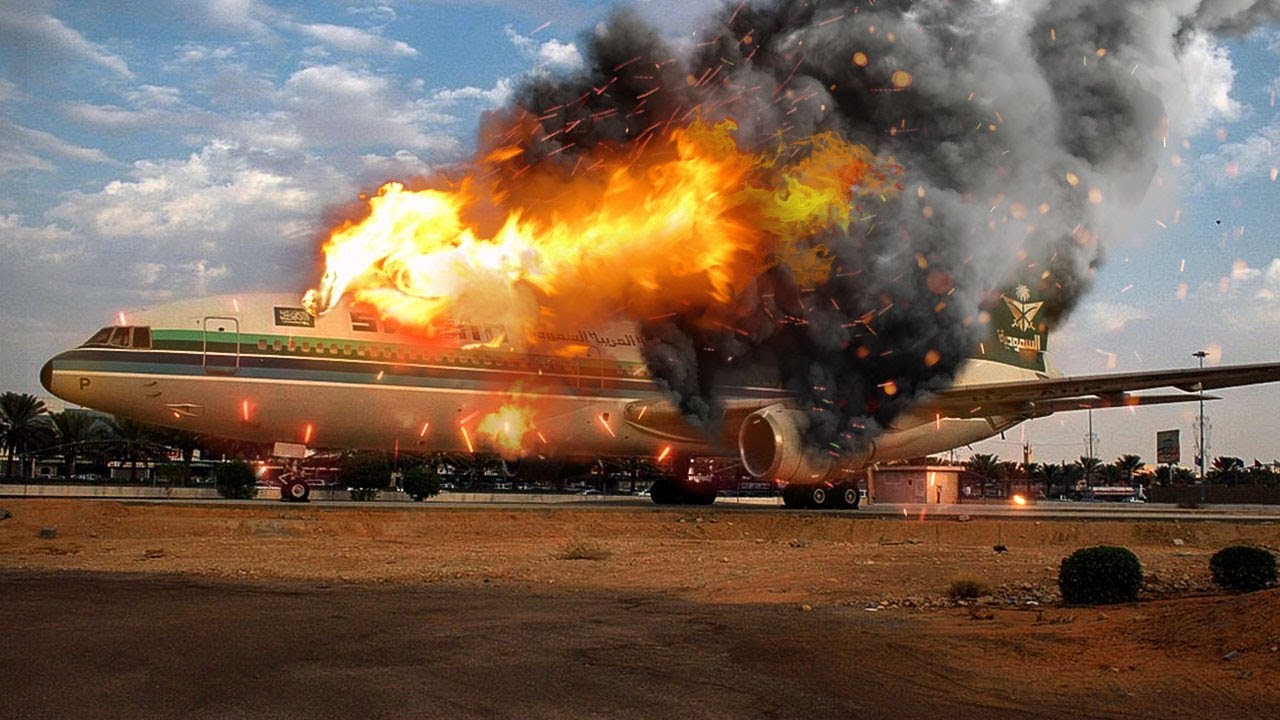The Plane Landed Safely… But Everyone Was Already Gone.
Imagine a flight touching down perfectly on the runway, no crash, no explosion—yet not a single soul steps off alive. On August 19, 1980, Saudia Flight 163 became the only plane in history to defy survival despite a flawless landing. What went so horribly wrong in those final moments? Why did 301 lives vanish in a plane that should have been saved? The chilling truth will leave you speechless.
👉 Uncover the haunting mystery behind this tragedy:

On August 19, 1980, Saudia Airlines Flight 163, a Lockheed L-1011-200 TriStar, etched its name into aviation history as the deadliest accident involving a safe landing. Departing from Riyadh International Airport (now Riyadh Air Base) en route to Jeddah, Saudi Arabia, the flight carried 287 passengers and 14 crew members. Just seven minutes after takeoff, a fire in the cargo hold triggered a chain of events that led to the loss of all 301 lives on board. Despite the aircraft landing safely back at Riyadh, no one survived. This article explores the timeline, causes, human factors, and lasting legacy of this haunting tragedy, drawing from official investigations and contemporary analyses.
The Fateful Flight
Saudia Flight 163 began its journey at Quaid-e-Azam International Airport (now Jinnah International Airport) in Karachi, Pakistan, with a scheduled stopover in Riyadh before continuing to Jeddah. The passenger manifest was diverse: 82 boarded in Karachi, and 205 joined in Riyadh, including Saudi and Pakistani pilgrims heading to Mecca for Hajj, 32 Iranian pilgrims, and diplomats from countries like Canada, France, and the United Kingdom. The aircraft, registered as HZ-AHK, was a relatively new Lockheed L-1011 TriStar, certified in 1979 with only 3,023 flight hours.
At 21:08 local time (18:08 UTC), the flight took off from Riyadh. Seven minutes later, at 21:14, smoke alarms in the C-3 cargo compartment alerted the crew to a fire. The crew, led by Captain Mohammed Ali Khowyter, First Officer Sami Abdullah M. Hasanain, and Flight Engineer Bradley Curtis, faced a critical situation. The next four minutes were spent verifying the alarms, with Curtis eventually confirming smoke in the cabin. Captain Khowyter decided to return to Riyadh, and at 21:20, First Officer Hasanain radioed their intent to land.
A Safe Landing, Then Tragedy
As the fire intensified, it burned through critical systems. By 21:25, the thrust lever for the center engine (engine 2) jammed, and by 21:29, the crew shut it down during the final approach. At 21:35, Khowyter declared an emergency and landed the aircraft safely at 21:36. The plane rolled to the end of the 4,000-meter runway, exiting onto a taxiway and stopping at 21:39, just 2 minutes and 40 seconds after touchdown. Emergency personnel, expecting a rapid stop, scrambled to catch up as the plane halted facing the opposite direction.
What followed was a catastrophic failure to evacuate. The crew reported shutting down the engines and preparing to evacuate, but the two wing-mounted engines remained running for another 3 minutes and 15 seconds until 21:42, preventing ground crews from opening the doors. No external flames were visible, but fire was seen through the rear windows. Communication with the crew ceased at this point. It wasn’t until 22:05—23 minutes after engine shutdown—that ground personnel opened the R2 door (second door on the right side). Three minutes later, at 22:08, the aircraft’s interior flashed over, consumed by fire. Autopsies revealed that all 301 occupants died of smoke inhalation long before the doors were opened, indicating they were likely incapacitated during or shortly after the landing roll.
The Crew: Experience and Errors
The cockpit crew’s inexperience with the Lockheed L-1011 contributed significantly to the disaster. Captain Khowyter, 38, had 7,674 flight hours but only 388 on the TriStar. Described as a slow learner, he struggled with the aircraft’s complexity. First Officer Hasanain, 26, had just 1,615 hours, with only 125 on the TriStar, and had previously been removed from flight training for poor performance. Flight Engineer Curtis, 42, had 650 hours as a flight engineer, including 157 on the TriStar, but his dyslexia may have impaired his ability to process information quickly under pressure.
The investigation highlighted critical lapses in crew resource management (CRM). The crew’s delayed response to the smoke alarms—taking four minutes to confirm the fire—wasted precious time. Khowyter’s decision to keep the aircraft pressurized during landing, with pressurization hatches nearly closed, likely trapped toxic smoke inside. Most damningly, the captain failed to order an immediate evacuation. The head flight attendant’s requests to evacuate were ignored or dismissed, with Khowyter reportedly telling the crew not to evacuate 30 seconds before landing. This decision, combined with the crew’s focus on routine procedures (like shutting down systems post-landing), sealed the passengers’ fate.
Investigation Findings
The Saudi Arabian General Authority of Civil Aviation led the investigation, pinpointing the fire’s origin in the C-3 cargo compartment. The exact cause remained undetermined, though two butane stoves and a used fire extinguisher were found in the wreckage, leading to an unproven theory that a passenger’s stove ignited the fire. The investigation ruled out this theory due to lack of evidence. Instead, it emphasized systemic and human failures:
Delayed Evacuation: The captain’s failure to initiate an immediate evacuation was catastrophic. Passengers and crew were likely incapacitated by smoke during the landing roll, as the aircraft remained pressurized.
Crew Inexperience: The crew’s limited experience with the TriStar led to poor decision-making and ineffective communication.
Inadequate Emergency Procedures: The ground crew’s delay in accessing the aircraft and the lack of training for external door operation exacerbated the situation.
Aircraft Design Flaws: The TriStar’s insulation above the cargo area allowed the fire to spread rapidly, and the lack of effective fire suppression systems in 1980 was a critical gap.
Autopsies confirmed that all victims died of smoke inhalation, not burns, underscoring the rapid spread of toxic fumes. The crew was found strapped in their seats, and passengers were crowded in the forward fuselage, likely fleeing the fire at the rear.
Impact on Aviation Safety
The tragedy of Saudia Flight 163 prompted sweeping changes in aviation safety, many of which remain in place today. The incident exposed the dangers of poor CRM, leading to global adoption of standardized CRM training to improve communication and decision-making in cockpits. Airlines revised emergency procedures, emphasizing immediate evacuation in fire-related incidents.
Lockheed modified the L-1011 design, removing flammable insulation above cargo compartments and reinforcing structural components with glass laminate. The U.S. National Transportation Safety Board recommended replacing traditional fire extinguishers with halomethane systems to better combat in-flight fires. Fire detection and suppression systems were also improved across aircraft models, with faster sensors and automated extinguishers becoming standard.
The disaster highlighted the importance of ground crew training. Procedures for accessing aircraft externally were streamlined, ensuring quicker response times. Pressurization systems were also re-evaluated to ensure automatic depressurization during emergency landings, preventing the buildup of toxic fumes.
The Human Toll
The loss of 301 lives—125 Saudis, 64 Pakistanis, 32 Iranians, and others from countries like Canada, Japan, and the UK—was a profound tragedy. Most passengers were pilgrims, their journey to Mecca cut short by a preventable disaster. The diverse nationalities underscored the global impact, with families across continents mourning loved ones. The incident remains the deadliest aviation accident in Saudi Arabia and the worst involving a Lockheed L-1011. At the time, it was the second-deadliest single-aircraft accident, surpassed only by Turkish Airlines Flight 981.
A Lasting Legacy
Saudia Flight 163 is a stark reminder of the fragility of life and the consequences of human error in high-stakes environments. The tragedy was not caused by a crash but by a failure to act decisively in the face of danger. It underscored the need for rigorous training, robust aircraft design, and clear communication protocols. While the aviation industry learned critical lessons, the cost was immense. The image of a plane standing intact on a taxiway, its passengers and crew already lost to smoke, remains one of the most haunting in aviation history.
Today, the lessons of Flight 163 are embedded in every pilot’s training, every aircraft’s design, and every airport’s emergency protocols. The tragedy transformed how the industry approaches fires, evacuations, and crew coordination, ensuring that such a loss would not be repeated. Yet, for the families of the 301 victims, the scars of August 19, 1980, endure as a somber reminder of what might have been.





